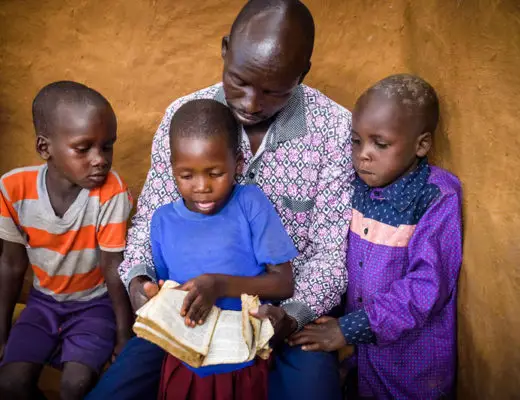“I am the true vine, and my Father is the gardener. He cuts off every branch in me that bears no fruit, while every branch that does bear fruit he prunes so that it will be even more fruitful. You are already clean because of the word I have spoken to you. Remain in me, and I will remain in you. No branch can bear fruit by itself; it must remain in the vine. Neither can you bear fruit unless you remain in me.
“I am the vine; you are the branches. If a man remains in me and I in him, he will bear much fruit; apart from me you can do nothing. If anyone does not remain in me, he is like a branch that is thrown away and withers; such branches are picked up, thrown into the fire and burned. If you remain in me and my words remain in you, ask whatever you wish, and it will be done for you. This is to my Father’s glory, that you bear much fruit, showing yourselves to be my disciples.
The I Am Statements of Jesus
Three launchpads for meditation. The first considers how this passage fits within the gospel of John.
The passage is situated within the ‘Farewell Discourse’ found in chapters 14-17. These chapters recount Jesus’ final words to His disciples the night before His crucifixion. In his goodbye speech, Jesus warns His disciples of impending opposition, but He also assures them of the coming of the Spirit and continued fruitfulness of their mission. Paradoxically, although Jesus is going away, the disciples are to continue experiencing a close union and communion with Jesus that overflows in fruitfulness.
With the emphasis on abiding in Jesus and bearing fruit, John records the final “I am” statement: “I am the true vine”. Paired with the seven signs or miracles of Jesus, the seven “I am” statements of Jesus reveal who He really is. The first six “I am” statements are: “I am” the bread of life (6:35, 48, 51), the light of the world (8:12; 9:5), the gate for the sheep (10:7, 9), the good shepherd (10:11, 14), the resurrection and the life (11:25), and the way, the truth, and the life (14:6).
The earlier “I am” statements focused on inviting people to come to Jesus and believe in Him. But now, in this intimate goodbye to His disciples, Jesus’ final “I am” statement is an invitation to remain in Him. The focus is on how the disciples, who have already come to Jesus, can continue in Jesus. But what exactly does remaining in Jesus as the true vine actually mean?
Old Testament Vine References
The second launchpad for meditation explores the use of vine imagery throughout the Old Testament.
The vine is a common symbol for the people of Israel. But when Israel is described as a vine, it is not a positive image. Rather than a healthy vine bearing fruit, Israel is portrayed as a wild or corrupt vine incapable of bearing fruit and in danger of God’s judgement.
For example, Isaiah 5:4-6 reads, “What more could have been done for my vineyard than I have done for it? When I looked for good grapes, why did it yield only bad? Now I will tell you what I am going to do to my vineyard: I will take away its hedge, and it will be destroyed; I will break down its wall, and it will be trampled. I will make it a wasteland, neither pruned nor cultivated, and briers and thorns will grow there. I will command the clouds not to rain on it.”
Although Israel is described as yielding bad fruit, it had not always been that way. Psalm 80 describes how God transplanted the vine of Israel from Egypt into the promised land where it flourished. However, as Jeremiah 2:21 describes, the planted vine of Israel became corrupt: “I had planted you like a choice vine of sound and reliable stock. How then did you turn against me into a corrupt, wild vine?”
Given this Old Testament backdrop, Jesus’ claim to be the true vine has profound meaning. Jesus is the one to whom Israel pointed, the vine that would actually bring forth good fruit. Where Israel failed, Jesus succeeded. As Isaiah 5:7 indicates, Israel failed with bloodshed rather than justice and cries of distress rather than righteousness. But Jesus shed His blood to satisfy the justice of God and cried out in distress on the cross as the righteous one suffered for the unrighteous.
With Jesus as the true Israelite, now the people of God are comprised of Jesus and his disciples, the vine and its branches. But what exactly does it mean to be a branch connected to Jesus as the true vine?
The Vine and Branches Metaphor
The third launchpad for mediation mulls over four aspects of the vine and branches metaphor.
First, a healthy branch is connected to the vine. The vine is the source of life. Jesus’ teaching and whole life bring new life to His disciples like a vine brings life to its branches. But to have life the branches must be connected to the vine just like we must abide in Jesus. This goes deeper than simply believing that Jesus exists, but includes sharing in Jesus’ emotions, thoughts, and source of power. As verse 7 indicates, having Jesus’ words abide in us as we abide in Him allows us to share in Jesus’ mind and will to such an extent that our prayers align with the purposes of God rather than our own selfish desires.
The second aspect of the metaphor to consider is how the close connection is part of a community. Each branch is closely connected to the vine, but each branch is also secondarily connected to every other branch through the common life-source of the vine. Christianity is always communal. Jesus binds us together just as branches are bound together by a vine.
The third aspect of the metaphor to explore is fruit bearing. What does it mean to bear fruit? Bearing fruit is to be understood broadly. Fruit is anything that flows from the vine to the branches. It can include love for one another, joy, effective witness to the world, obedience to God’s commands, or anything that flows from having life in Jesus.
The final aspect to consider is the pruning that is mentioned in verse 2. Branches that are fruitful are pruned so as to be even more fruitful. To understand the role of pruning, it is helpful to consider Warren Wiersbe’s reflection on the difference between fruit and results: “A machine can produce results, and so can a robot, but it takes a living organism to produce fruit. It takes time and cultivation to produce fruit; a good crop does not come overnight.”
Bearing fruit is a process; it takes time. Since it is organic, it is messier than a robot working in a factory. To help us experience more fruitfulness, the Father acting as a gardener prunes us. Pruning includes not only God removing the dead areas of our lives, but also cutting away good things so as to make room for what is even better. One primary way God prunes His people is through His Word. God’s Word reveals the dead areas of our lives and helps cut away the sin that so easily entangles.
As a branch, stay connected to Jesus as the source of life and embrace the process of sanctification as God prunes your life to give you an even more abundant life as you produce sweet fruit that is enjoyed by others.
John 15:1-8 Study Resources
Be Transformed (John 13-21) (Wiersbe 2009):
John (IVP New Testament Commentary) (Whitacre 2010):
The Gospel According to John (PNTC) (Carson 1991):
The Gospel of John: A Theological Commentary (Ridderbos 1997):




One Reply to “The True Vine”